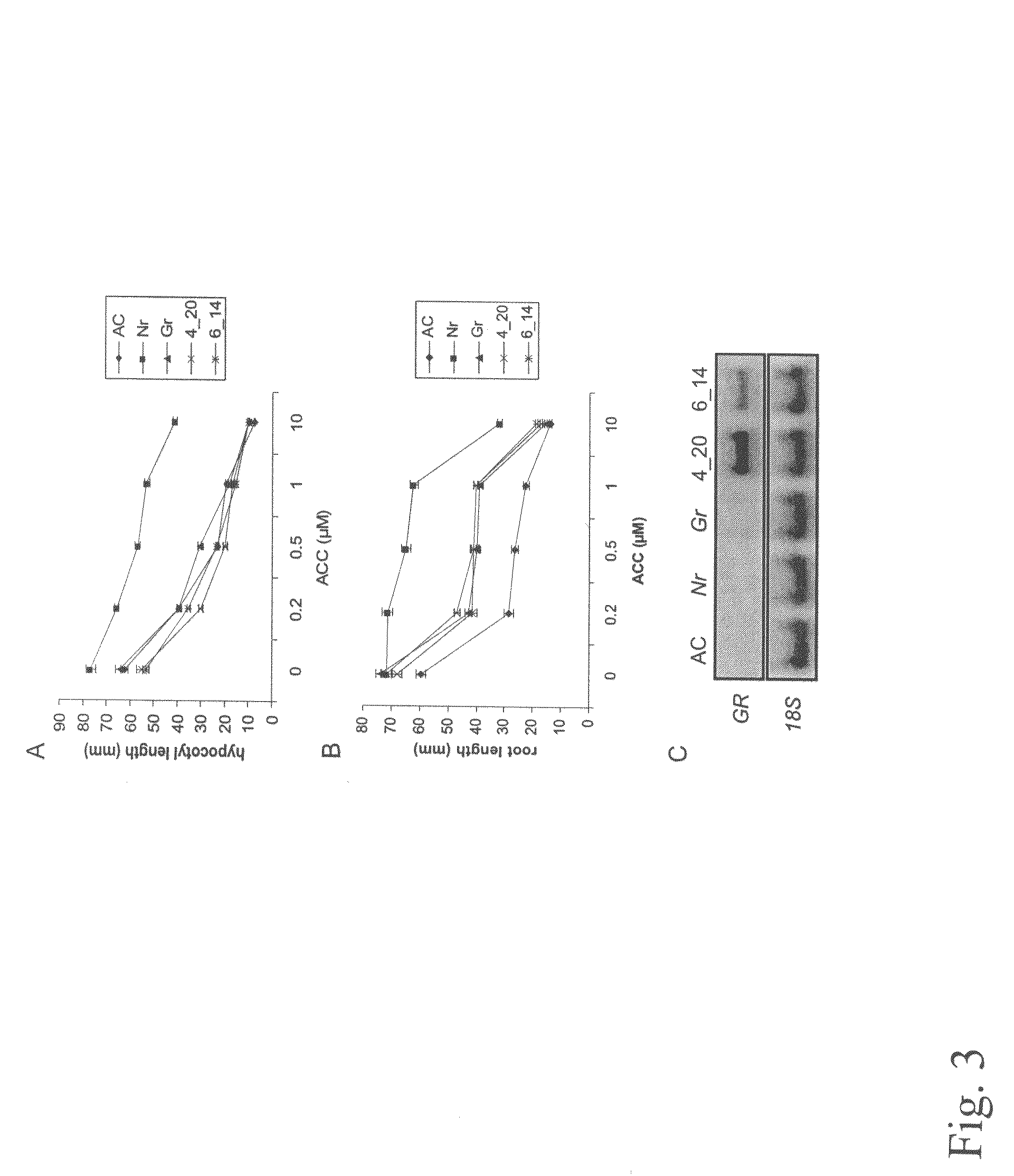Ripening inhibition in the tomato Green-ripe mutant results from ectopic expression of a novel protein which disrupts ethylene signal transduction
a technology of ethylene signal transduction and ethylene, which is applied in the field of ripening inhibition in the tomato green-ripe mutant results from ectopic expression of a novel protein which disrupts ethylene signal transduction, can solve the problems of reduced fruit quality, reduced shelf life, added production, etc., and achieve the effect of modulating fruit ripening and flower senescen
- Summary
- Abstract
- Description
- Claims
- Application Information
AI Technical Summary
Benefits of technology
Problems solved by technology
Method used
Image
Examples
example 1
Plant Materials
[0081]All mutant lines and mapping populations used in this study have been previously described (Barry et al., supra). Briefly, homozygous lines carrying the Gr / Gr and Nr-2 / Nr-2 mutations and the wild tomato species Solanum cheesmaniae (accession nos. LA2453, LA2455, and LA483, respectively) were obtained from the Tomato Genetics Resource Center, UC Davis. Homozygous Nr / Nr seed and the parental cultivar AC (nr / nr) were originally obtained from the Glasshouse Crops Research Institute (Littlehampton, Sussex, UK). Plants were grown in peat-based compost supplemented with fertilizer in greenhouses equipped with heating and cooling systems and supplemental lighting at Cornell University campus in Ithaca, N.Y. Fruit were harvested at five developmental stages (termed 1-5). For the AC cultivar, these were mature green (stage1), breaker (stage 2), breaker+3 d (stage 3), breaker+7 d (stage 4), and breaker+10 d (stage 5). To account for the more protracted ripening observed fo...
example 2
Nucleic Acid Analysis
[0083]Genomic DNA isolation and genetic mapping were performed as previously described (Barry et al., supra). Briefly, genomic DNA was extracted from fresh meristematic leaves using a microprep isolation protocol modified from Fulton et al. (1995). Approximately six meristematic leaves were placed into a 2-mL screw-cap tube and kept on ice. Samples were homogenized in 290 μL of extraction buffer (0.35 M sorbitol, 0.1 M Tris-base, 5 mM EDTA, pH 7.5, containing 3.8 mg / mL sodium bisulfite) in a Savant FP120 Fast Prep machine. A total of 290 μL nuclear lysis buffer (0.2 M Tris-HCl, pH 8, 0.05 M EDTA, pH 8, 2 M NaCl, 2% (w / v) hexadecyl-trimethyl-ammonium bromide) and 140 μL 5% sodium lauryl sarcosine were added and the samples vortexed and incubated for 40 min at 65° C. A total of 700 μL of chloroform / octanol (24:1) was added and the samples were vortexed and centrifuged at 8,000 rpm for 15 min. The supernatant was transferred to a 1.5-mL microfuge tube and the DNA p...
example 3
High Resolution Genetic and Physical Mapping of the Nr-2 and Gr Loci
[0087]Utilizing F2 populations segregating for normal and non-ripening fruit between S. lycopersicum (Gr / Gr)×S. cheesmaniae (gr / gr) and S. lycopersicum (Nr-21Nr-2)×S. cheesmaniae (nr-2 / nr-2), we positioned the Gr and Nr-2 loci to overlapping regions of the long arm of tomato chromosome 1 with tight linkage to the RFLP marker TG333 (Barry at al., supra). The mapping resolution of each locus was increased to approximately 0.03 cM per recombination event by screening for recombinants between TG260 and TG245 in 1810 and 1856 F2 individuals segregating for Nr-2 and Or respectively. Simultaneously, TG333 was used to screen ordered BAC libraries derived from Solanum lycopersicum and Solanum cheesmaniae (Li et al., supra; Budiman et al., supra). A total of 13 BAC clones were recovered from these screens (data not shown). The ends from clone 93D5 (FIG. 1A) were isolated by direct sequencing and converted into the RFLP marker...
PUM
| Property | Measurement | Unit |
|---|---|---|
| temperature | aaaaa | aaaaa |
| Tm | aaaaa | aaaaa |
| temperatures | aaaaa | aaaaa |
Abstract
Description
Claims
Application Information
 Login to View More
Login to View More - R&D
- Intellectual Property
- Life Sciences
- Materials
- Tech Scout
- Unparalleled Data Quality
- Higher Quality Content
- 60% Fewer Hallucinations
Browse by: Latest US Patents, China's latest patents, Technical Efficacy Thesaurus, Application Domain, Technology Topic, Popular Technical Reports.
© 2025 PatSnap. All rights reserved.Legal|Privacy policy|Modern Slavery Act Transparency Statement|Sitemap|About US| Contact US: help@patsnap.com



